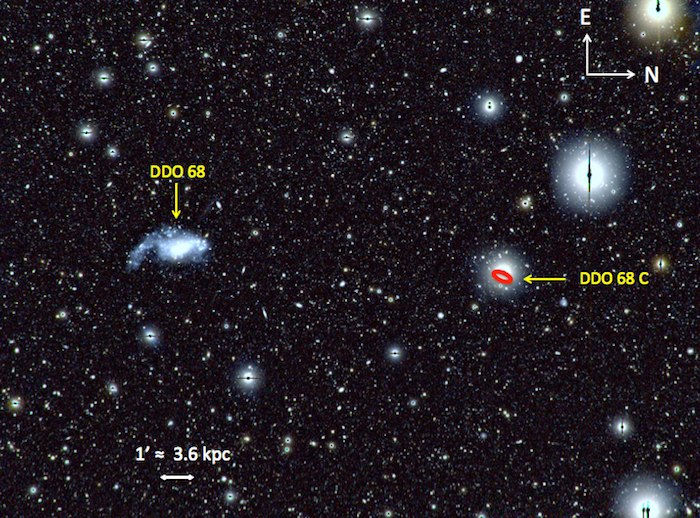.

This visible-light image taken with the Large Binocular Telescope shows dwarf galaxy DDO 68, which lies in a comparatively "empty" region of space 39 million light-years from Earth, and one of its companion objects, DDO 68 C. The scale bar indicates a distance of 3.6 kiloparsecs, or just under 12,000 light-years. Image courtesy Francesca Annibali/INAF.
-
Even a dwarf galaxy with very low mass is capable of accreting smaller nearby galaxies, according to an international team of astronomers led by Francesca Annibali of INAF, the Italian National Institute for Astrophysics. This result has been achieved thanks to observations of the region surrounding the dwarf galaxy DDO 68, which has a total stellar mass of only 100 million solar masses, roughly one thousandth of our Milky Way.
Within the scenario of hierarchical galaxy formation, theoretical models predict that galaxies form by successive mergers of smaller systems at all scales. However, until now, direct observational evidence confirming these predictions was available only for massive galaxies and their smaller companions.
In the new study, Annibali and collaborators took advantage of the sensitivity and the large field of view of the Large Binocular Telescope, or LBT, located on Mt. Graham in southeastern Arizona (U.S.). The team discovered that DDO 68, a dwarf galaxy located in an isolated region of space defined as a "void," is actually surrounded by a number of smaller satellite galaxies, and is accreting them.
"In a way, what we saw reminded us of a quote by Jonathan Swift," Annibali said. "'So, naturalists observe, a flea has smaller fleas that on him prey; and these have smaller still to bite 'em; and so proceed ad infinitum.' It turns out that even the smallest of galaxies feed on companions that are even smaller, and so our paper bears that quote in its title."
DDO 68 is one of three known least evolved galaxies among those that still form stars, with a chemical composition not much different from that resulting from the Big Bang. Scientists had already thought that its extremely irregular morphology - with a long tail hosting both stars and gas - could be due to tidal effects resulting from gravitational interactions with other bodies. Incidentally, a candidate companion - possibly another small galaxy or a gas cloud - was spotted at a relatively large distance two years ago by a team led by John Cannon of Macalester College in Minnesota.
"When we analyzed our Hubble Space Telescope images, we detected an anomalous protuberance off DDO 68's main body," said Francesca Annibali, a postdoctoral fellow/researcher at the INAF - Astronomical Observatory in Bologna, Italy.
"We thought that only LBT with its two 8.4 meter primary mirrors could have the power and the field of view necessary to prove, or disprove, the presence of a stream and other accreting satellites."
LBT's wide and deep images revealed that DDO 68 not only has its well known long tail, but also another small, incoming stream and a few other star and gas companions that most likely are satellites whose ultimate fate is to be accreted.
The stream and satellites probably have masses - about 100,000 solar masses - similar to, or even lower than, those of the ultra-faint Milky Way satellites, the least luminous and smallest galaxies known so far, believed to be the closest local analogs of the first galaxies.
"Our colleagues, Luca Ciotti and Carlo Nipoti of the Physics and Astronomy Department at the Bologna University, have computed numerical dynamical models of DDO 68's system that reproduce very well the observed configuration of the 'flea with its smaller fleas,'" Annibali pointed out.
"This is the first evidence of a stellar stream around an isolated dwarf galaxy of only a hundred million solar masses, and the observational proof that hierarchical galaxy formation processes work also at the smallest scales."
"In other words, not only massive bodies are able to cannibalize the smaller ones that happen to lie in their surroundings, but the same appetite and digestion capabilities can be found in the smaller ones," added Monica Tosi, INAF astronomer and member of Annibali's team.
Dwarf galaxies with active star formation are important in helping scientists understand the formation and evolution of galaxies in general.
Of those, galaxies that are extremely poor in metals, such as DDO 68, are even more interesting, because in spite of having formed stars for many billions of years, they haven't been able to retain the chemical elements produced by nuclear fusion inside stars. Most likely they have lost their metals via ejection into the surrounding medium through galactic winds triggered by supernova explosions.
"It is very interesting to discover that a system whose gravitational potential is too low to retain ejecta from supernovae is still capable of attracting and accreting smaller galaxies," Tosi said. "Specific dynamical and hydrodynamical studies are necessary to understand what main mechanisms are at play here."
"The results achieved with DDO 68 show the high discovery power of wide-field instrumentation mounted on 8- to 10-meter class telescopes for future projects devoted to the search of substructures around isolated dwarf galaxies," she added. "It also emphasizes the importance of combining deep observations with theoretical studies on the evolution and the dynamics of both stars and gas in the galaxies we study."
Quelle: SD
